Author: Four Pillars; Translation: 0xjs@金财经
Key points
Intellectual property rights in the digital field ( IP) management faces significant challenges and new intellectual property management systems need to be developed to cope with the emergence of advanced AI technologies and various IPs that utilize these technologies.
Creators can register their IP on Story Protocol to easily track usage of their IP and enforce revenue rights from derived IP through code. This provides a structured approach to IP registration, licensing and royalty distribution.
By protocolizing the system that protects and enhances creator IP, Story Protocol will lay the foundation for further expansion of the IP industry in the digital world, ultimately becoming the liquidity of programmable IP layer.
1. A new paradigm of cooperation
Cooperation is the key to music. The completion of a song requires the efforts of many people, and it is difficult to complete it with just one person's ideas or efforts. Recent advances in the Internet, social media and AI technology have dramatically changed the paradigm of music collaboration.
1.1 Internet: Collaboration between artists

Source: Drake’s Donda
Before the internet, artists had to be physically present in the same studio to create music together, which limited the scope of their collaboration. However, with the advent of the Internet, melodies written on one's own computer can be sent to each other in the form of wav files or flp project files without any physical restrictions.
How many people were involved in Kanye West's Donda's song "Hurricane"? According to sources, a total of 43 people participated in the production of this single, of which 6 were responsible for vocals, 11 were responsible for production, 18 were responsible for engineering, and 23 were responsible for composing and writing lyrics.
Although not like Kanye West’s “Hurricane,” having multiple people contribute to a song is a common trend. For example, if you look at the song "No Stylist" by Destroy Lonely, you'll see that Cxdy and Chef9thegod contributed to the song, with Chef9thegod writing the overall melody and Cxdy writing the drum line. This division of labor is partly due to the natural specialization of each composer as the industry develops, but I think the commercialization of the Internet is the biggest reason.
1.2 Social media: collaboration between artists and fans
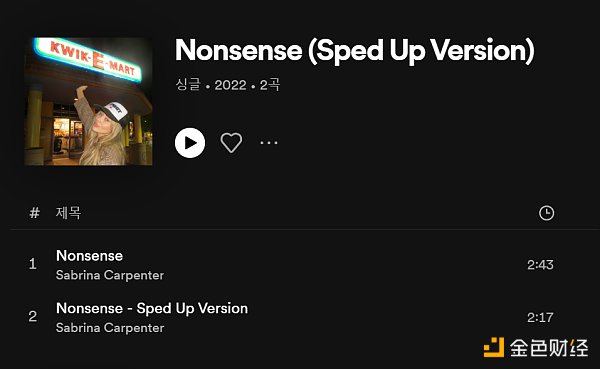
Source: Sabrina Carpenter @ Spotify
As the internet progressed and social media emerged, it began to significantly impact the way music was distributed once it was released.
Currently, the most important platform in the music industry is TikTok. Due to the length of short videos and the nightcore trend (note: nightcore is a music composition technique that increases the speed of sound approximately 1.35 times and raises the pitch), KOLs began creating TikToks with "accelerated" versions of existing songs. In fact, unofficial Speed Up versions have always existed on YouTube, but the popularity of these videos on TikTok prompted artists and labels to release Speed Up versions as official tracks.
In addition to TikTok, personally curated playlists on YouTube and Spotify also play an important role in promoting and discovering music. There is so much music out there, I'm sure I'm not the only one who has had the experience of listening to a playlist curated by tasteful people on YouTube, finding a great song in the middle, and then going back to find the artist. For example, even though this playlist (https://www.youtube.com/watch?v=75kySTFaBQQ) only features Korean independent artists, it is extremely popular with over 12 million views and over 12 million comments. Today, being included in a popular playlist on Spotify has become a key factor in a track’s success.
1.3 AI: Blurring the boundaries between artists and fans
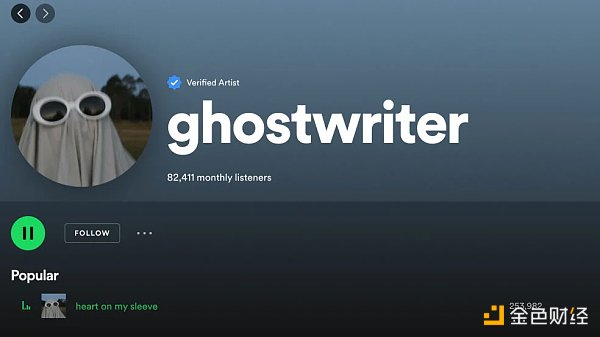
Source: @jenny____ai
< p>Drake and The Weeknd's song "Heart on My Sleeve" is the hottest song in the second quarter of 2023, but the problem is that it was not released by the two artists, but by an anonymous TikToker named "ghostwriter977" The user uses the voices of two artists produced with AI. "Heart on My Sleeve" was released on all music streaming platforms on April 4 and was removed by UMG on April 17. In just a short time, it has racked up 600,000 plays on Spotify, 275,000 views on YouTube and over 15 million views on TikTok. More than 1,000 TikTok videos were produced, and Billboard estimated the song's total revenue to be around $9,400. If Drake or UMG composed the song themselves, it would be a huge viral marketing move, but if they didn't, it's proof that we're at the beginning of a new era where anyone can use anything with the help of AI They wanted famous people's voices to write songs.
In fact, Voicify lets you easily create your own AI cover songs, while Mubert lets you create your own mood music. Splice, the largest music sample service, now uses AI models trained on its library to find the best combinations of samples and make recommendations.
1.4 Changes in the supply chain
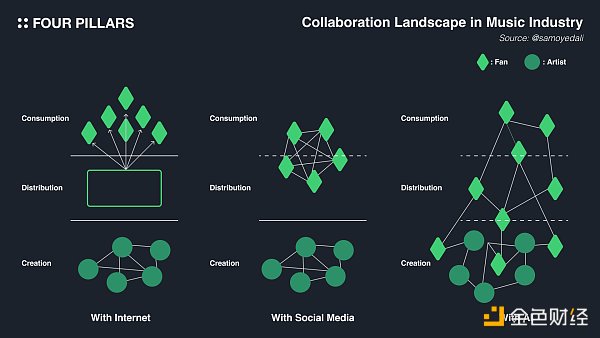 In summary, the emergence and commercialization of technologies such as the Internet, social media, and AI have made collaboration among people in the music supply chain easier and more active. With the advent of the Internet, collaborations between artists have increased. With the emergence of SNS, collaboration between artists and their consumers has increased; with AI, the boundaries between artists and consumers are becoming blurred, and the scope of collaboration is also expanding. In particular, before AI, collaboration between artists and consumers was limited to distribution and promotion, but now it will become a regular part of music creation. For example, if Drake's fans don't like his new album, they'll start making their own songs using Drake's voice.
In summary, the emergence and commercialization of technologies such as the Internet, social media, and AI have made collaboration among people in the music supply chain easier and more active. With the advent of the Internet, collaborations between artists have increased. With the emergence of SNS, collaboration between artists and their consumers has increased; with AI, the boundaries between artists and consumers are becoming blurred, and the scope of collaboration is also expanding. In particular, before AI, collaboration between artists and consumers was limited to distribution and promotion, but now it will become a regular part of music creation. For example, if Drake's fans don't like his new album, they'll start making their own songs using Drake's voice.
2. Credit conflict
Cooperation is an important foundation for culture and industry, but as more and more entities participate in cooperation, problems have also increased significantly. This is mainly due to the issue of credit.
2.1 Production Credit
As collaborations between producers become more frequent, it is not uncommon for lesser-known producers to go uncredited. For example, Kanye West produced the beat for Nas's "Poppa Was a Playa" early on, but his mentor D-DOT didn't take credit for it. Recently, a German Billboard producer named PVLACE was criticized for taking beats and samples from former colleague Gunboi without authorization and selling them under his own name. There are two main reasons why these things happen.
Difficulty tracking creation: beatmakers often send their samples to different producers, and it is impossible for them to track whether their samples were produced by used. So if a malicious producer uses your sample without authorization and doesn't pay you, it's hard to know. It's also unrealistic to prove that your sample was used on the track.
The complexity of the copyright process: For big-name producers, there are people and companies who will handle the legal aspects of copyright for them, but as an individual, dealing with this process is not easy. easy. For example, if you want your music to be paid globally, you have to join multiple copyright authorities in each country, which is expensive and time-consuming, not to mention the issue of dual contracts. So when it comes to collaborations, less well-known producers are more likely to just do what famous producers tell them.
Due to these difficulties, it is not easy for lesser-known producers to maintain 100% rights when collaborating.
2.2 Credit for distribution
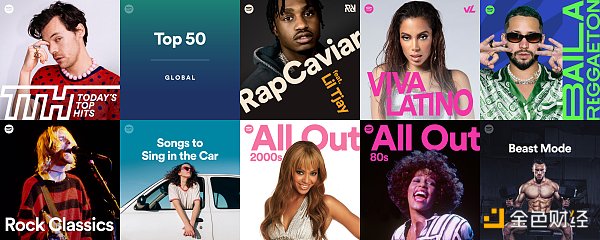
Source: RouteNote
In fact, the top TikTok network Hong and YouTube creators are paid by record labels to create promotional content for specific songs. Of course, these creators are the starting point for viral videos, but virality requires the help of other individual creators to continue. Virality can only be created and sustained from the bottom up through individuals creating TikTok and YouTube videos for fun, fandom, or self-fulfillment.
However, it is difficult for these temporary KOLs to get their own credit for the viral impact they have on a specific track. TikTok requires high followers and viewership to monetize the videos themselves, and is only available in limited regions. On YouTube, music playlist videos cannot be monetized through AdSense, so it is difficult to monetize them unless working with an outside brand, which is only possible with reputable accounts. At Spotify, internal curators are paid well, but external curators have no way to make money.
All of these platforms have one thing in common: they reward a few well-known creators, but not the small individual independent creators who are often the backbone of viral videos.
2.3 Credit for sound
The number of cover tracks created by artists using AI-generated sounds is unlikely to decrease in the future. In this case, artists and labels need to be able to defend their rights. Major record labels are already waging a war with AI over the unlicensed use of their catalogues, but this is unlikely to stop the trend. Artists like Grimes have taken the opposite approach, and instead of making AI-generated sounds open for easy use, they are forcing royalties for commercial use such as a 5:5 split.
3. Basic issues
In fact, the changes and issues discussed so far are the same across the entire IP industry, not just in the music field. I think the root cause of these problems is the lack of an Internet-based IP management system.
3.1 Regulation of Digital IP
In the United States, since the 1990s, the Digital Millennium Copyright Act (DMCA) has been trying to deal with the issues of the digital age. The DMCA broadly includes the following provisions:
Prohibition of circumvention of technological protection measures: Prohibition of circumvention of technological protection measures to prevent unauthorized access to and copying of digital content .
Protect online service providers: It is difficult for online service providers such as YouTube to verify whether content posted by users infringes copyright. The DMCA exempts online service providers from liability for copyright infringement if they comply with certain conditions.
Notice and Takedown Procedure: If a copyright owner discovers a copyright infringement, they can notify the online service provider and the content must be removed.
As far as we know, most online platforms follow this provision of the DMCA to monitor copyright infringements. For example, YouTube’s Content ID system is heavily influenced by the DMCA. This is a system that automatically checks uploaded videos against YouTube's database to see if they infringe copyright, and if so, the copyright owner can take various actions. If the system misses it and the copyright owner manually requests removal, the platform can still remove the video under the DMCA.
3.2 Limitations of the Digital Millennium Copyright Act (DMCA)
In my opinion, there are two main problems with the DMCA.
First of all, the DMCA is outdated. While it’s great that original creators’ rights are respected, social media and AI have brought about more collaboration and secondary creation, and the DMCA has not kept up with these changes.
Secondly, the DMCA does not provide copyright owners with specific guidance or methods on how to manage and track their intellectual property rights. Therefore, although the DMCA is theoretically designed to protect the rights of original authors, in practice it fails make it happen. Unless part of a larger company, copyright holders must use third-party services and use resources at their own expense.
3.3 What We Need
The DMCA served its purpose well in the early days of the Internet. But now we need a new infrastructure. I say infrastructure, not regulation, because it seems to me that regulation only exists to prevent certain behaviors, and we're not in that era yet. A digitally native IP infrastructure that fits current trends should do the following:
Provide original authors with tools and guidance to track and monitor Usage of his works. Simply saying "if your copyright has been infringed, you can always have it removed" doesn't take into account the actual situation. You need to go a step further and provide a method or tool that makes it easy for anyone to see how their copyright is actually being used.
We need to ensure that both original creators and secondary creators benefit. Original authors should be able to ensure that their rights are not infringed, while secondary creators should be able to confidently recreate and claim credit for existing IP.
4. Story protocol

Source: Story protocol
In short, Story Protocol is an infrastructure that provides a framework for registering on-chain IPs and extending these IPs. Story Protocol aims to be the new infrastructure for digital-based IP. It is not intended to replace legacy regulations and infrastructure that are already in place, but just as arXiv.org has become an increasingly important parallel for academic papers, we believe Story Protocol can play a similar role for digital-based IP.
4.1 Story Protocol Architecture
Story Protocol adopts a structure inspired by TCP/IP and aims to be a programmable IP layer. It mainly consists of a data layer (called nouns) and a functional layer (called verbs (modules)), on top of which is an ecosystem that leverages the story protocol.
Nouns: As the data layer, including the core elements of the story agreement, such as IP assets, licenses and royalties.
Verbs: This layer defines the various operations that can be taken on the data defined in the noun.
4.2 Nouns
Let’s explore the key elements defined in nouns in a story agreement.
4.2.1 IP Asset
In Story Protocol, IP is called IAsset, which represents an on-chain NFT that describes the IP and associated IPAccount. Unlike static NFTs, IPAssets are programmable in nature and serve as the basic unit of the Story protocol. IAssets contain metadata such as IP type, creator, IPA number, etc. An important attribute to note is the IPAccount, as the IPAccount's address is included in the IAsset as a unique ID, helping to easily manage and track related information. information.
4.2.2 IPAccout
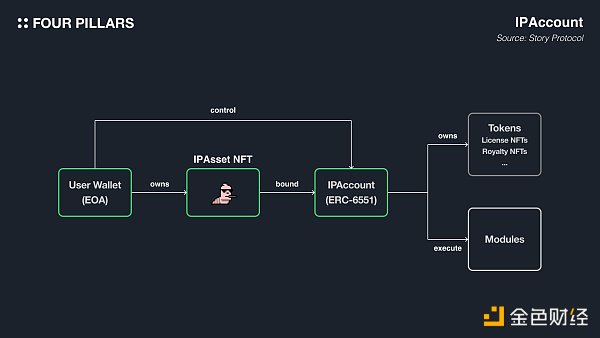
IPAccounts are accounts based on a modified version of ERC-6551 that are paired with each IAsset and transferred together with the ownership of the IAsset. Being ERC-6551 compliant, they can hold tokens such as License NFTs and Royalty NFTs and execute various modules. All interactions in Story Protocol revolve around IPAccount, supporting key features such as licensing, royalty sharing, and remixing. The core functionality of IPAccount is to call any Verb (module) through the execute() function.
4.3 Module (Verbs)
The main function of the module is to change the data/status related to IP. Nouns record data related to IP, while modules (Verbs) provide a framework for interacting with this data. In addition to basic Modules, Story Protocol also allows ecosystem developers to build Hooks based on the Module framework. Let’s analyze the main modules:
4.3.1 Permission module
Story Protocol can be regarded as a social network that defines the relationship between IPs on the blockchain Graph, where the license defines how the derived IP connects to the social graph. Creators in Story Protocol can recreate various IPs into videos, images, and more. The rights to assign IPs are critical in this process and are managed by the licensing module.
IP rights are represented in the form of license NFTs, containing information such as the IPAsset's ID and policy ID, and are identified by a unique license ID. Licensed NFTs follow the ERC-1155 standard, allowing for multiple NFTs. Policies define licensing terms related to intellectual property, such as commercial use or transferability of the license. IP owners can choose from a variety of strategies through combinations.
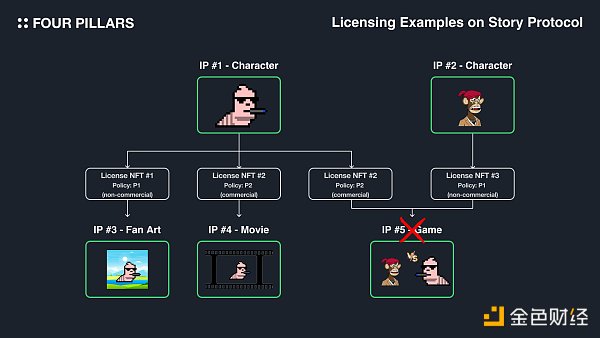 Only for specific IP Only the holder of the licensed NFT can create a derived IP from that parent IP, and once the derived IP is registered under the parent IP, the licensed NFT is burned. For example, let's say the owner of Larva Lads registered IP #1, minted one licensed NFT #1 with a non-commercial use policy (P1), and two licensed NFT #2 with a commercial use policy (P2). The owner of License NFT #1 can burn it to register non-commercial fan art as IP #3. Likewise, the owner of license NFT #2 can register a commercial film as IP #4.
Only for specific IP Only the holder of the licensed NFT can create a derived IP from that parent IP, and once the derived IP is registered under the parent IP, the licensed NFT is burned. For example, let's say the owner of Larva Lads registered IP #1, minted one licensed NFT #1 with a non-commercial use policy (P1), and two licensed NFT #2 with a commercial use policy (P2). The owner of License NFT #1 can burn it to register non-commercial fan art as IP #3. Likewise, the owner of license NFT #2 can register a commercial film as IP #4.
Derivative IPs can also be registered under two parent IPs, allowing innovative content to be created through a combination of various IPs. However, if the License NFTs of two parent IPs have conflicting policies, the derived IP cannot inherit both. For example, if someone were to create a commercial game using IP #5's Larva Lads and BAYC characters, but the owner of IP #2 only followed the non-commercial P1 policy to issue a licensed NFT, they would not be able to register it.
4.3.2 Royalty Module
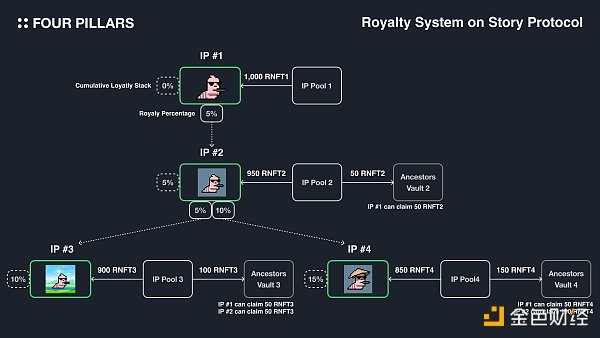
Story Protocol introduces the ability to enforce IP usage fees through code, solving common problems in traditional IP environments. A royalty policy can be defined between two IAssets, setting the minimum royalty percentage that the parent IAsset can charge for IP derived from it. Each IPAsset has an IP pool holding 1,000 ERC-1155 royalty NFTs, with holders receiving a proportional share of the revenue generated by the associated IP pool.
For example, if IP #2 registers with a royalty of 5% of IP #1, then 5% of the 1,000 RNFT2 (50 RNFT2) will be deposited into Ancestors Vault 2, and IP #1 will have The right to claim these 50 RNFT2. Likewise, if IP #4 registers with a 10% royalty charge to IP #2, then 15% of the 1,000 RNFT4 (150 RNFT4) (5% from IP #1 and 10% from IP #2) will be deposited in Ancestors Vault 4 , IP #1 has the right to claim 50 RNFT4, and IP #2 has the right to claim 100 RNFT4. This mechanism allows parent IPs to claim a portion of the revenue generated by their derived IPs.
While tracking IP usage and collecting royalties in the digital space has always been challenging, Story Protocol successfully solves this problem. However, as the IP relationship tree deepens, the cumulative royalty percentage can increase significantly, highlighting the importance of selecting an appropriate royalty percentage.
4.3.3 Dispute Module
What happens if a malicious user uses someone else’s IP but claims to have created an original IP? To solve this problem, the Story protocol includes a dispute module for mediating disputes. If malicious activity is proven, offending IPs and their owners will face penalties.
4.4 Registration
IPAccount stores information related to a specific IP, while registration is used to store the global state of Story Protocol. The types of registration centers include:
IAssetRegistry: manages the IAsset registered within the protocol and deploys the corresponding IPAccount.
Registered modules: Manage and update the global list of modules and hooks registered without permission.
License Registration: Manages interactions related to license NFTs and stores all license-related information.
4.5 Potential Users
4.5.1 IP Owner
If the IP owner can send it via Story Protocol Intellectual property is registered as IPAssets (Intellectual Property Contracts) to protect their rights and encourage derivative works, then they have no reason not to use it.
4.5.2 Creators
For creators if their favorite IP is IAsset on Story Protocol and the benefits of receiving fair royalties offset using the protocol trouble or difficulty, then there is no reason not to use it.
4.5.3 Investors
If investors want to invest royalties from a specific IP, they can easily do so by purchasing Loyalty NFTs through platforms such as Opensea or Blur. However, in order for this process to be seamless, firstly, competitive IPs must be registered on Story Protocol, and secondly, Story Protocol must be able to effectively manage and track off-chain royalties.
5. Looking to the future
Story Protocol currently lacks the ability to take legal action against IP copyright infringement, and tracking royalties off-chain is not simple. So, can Story Protocol become the new infrastructure of Internet IP? I can't say for sure. Still, the issues Story Protocol focuses on are real, and they do exist on the internet.
The emergence of technology-based parallel institutions will be an important trend in the future, giving people more choices and stimulating the development of existing infrastructure. Story Protocol is ideally suited to function as a parallel organization, especially in the IP space. If Story Protocol can identify and pinpoint the clear needs of IP owners, we may soon see a world where copyright owners don’t have to worry about their creations being used without authorization and secondary creators are free to use the IP they want. An environment to recreate and receive corresponding royalties.
 JinseFinance
JinseFinance
 JinseFinance
JinseFinance JinseFinance
JinseFinance JinseFinance
JinseFinance JinseFinance
JinseFinance JinseFinance
JinseFinance JinseFinance
JinseFinance JinseFinance
JinseFinance Joy
Joy Wilfred
Wilfred Cointelegraph
Cointelegraph